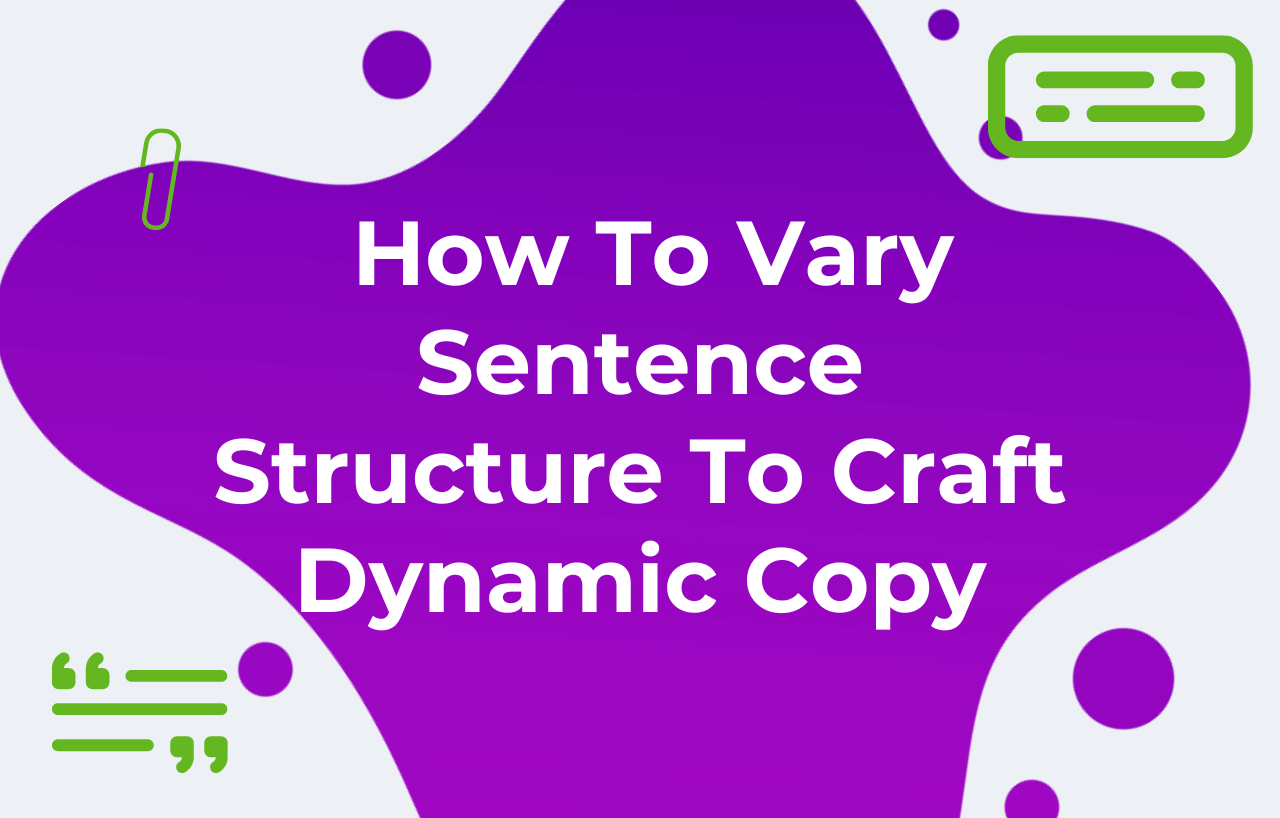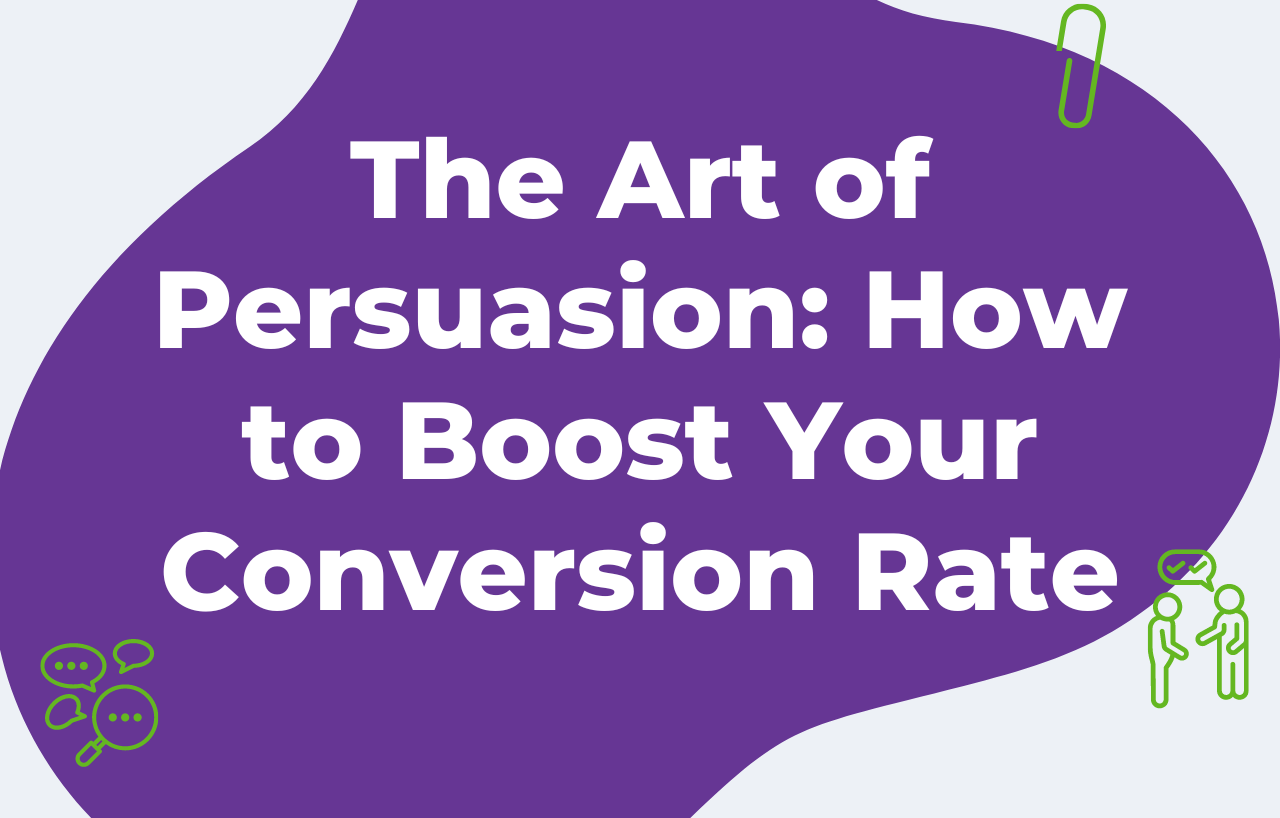All of our content is researched and written by human writers. No robots here!
As a digital agency owner, if you or your clients write your own content, you deal with a lot of copy day in and day out. So, you’re no stranger to syntax and sentence structure. You’ve probably got a pretty good idea what it is. (Don’t worry if you don’t, though—I’ll explain in a sec!)
But do you know how sentence structure works? Should you?
A good variety of well-structured sentences gives your copy more than a dynamic rhythm. It emphasises your message and keeps your audience engaged—and more likely to convert. Stagnant, faulty sentence structure does the opposite.
By the time you finish this blog, you’ll understand what sentence structure is, and why it’s important not just to get it right, but to shake it up and keep the rhythm fresh throughout your copy. I’ll show you some examples, so you’ll be able to recognise a sentence both by its structure and its function.
With these new tools in your copywriting belt, I’ll also reveal how to add variety to your content to keep readers on the page—and coming back for more.
Sound good? Great—let’s find out what makes good copy tick!
What is sentence structure?
Sentence structure is the order in which words and phrases are placed—or how grammatical elements like the subject, verb, and direct or indirect objects are arranged—in a sentence.
Think back to your childhood. Did you ever dump a whole bucket of LEGO onto your bedroom floor and spend the entire afternoon putting them together and pulling them apart again? You might never make the same thing twice—and that was the fun of it! There seemed to be no limit to what you could build if you had enough pieces, a bit of creativity, and a few hours free to play.
Sentence structure is a bit like that. Words, phrases, and clauses are the building blocks of our sentences. Structure is the shape they take when we put them together.
Sentence structure impacts a reader’s comprehension and emotional response. Depending on how it’s used, it can establish (or disrupt) the rhythm, flow, clarity, and tone of your content. And just like LEGO, we can put the pieces of a sentence—or multiple sentences—together in different ways to create different effects.
The building blocks of basic sentence structure
Wait… what’s the difference between a direct and an indirect object again? And… what exactly is a clause? 🤔
Let’s go back to basics for a sec.
A clause is a phrase containing a subject and a verb. Subjects and verbs are the fundamental elements of a simple sentence. Sometimes, you can express a complete idea with just two words. For example: “I write.” Here, ‘I’ is the subject, and ‘write’ is the verb. If there were a direct object in this sentence—say, ‘a blog’—it would follow the verb like this: “I write a blog.” Beyond these, we’re free to add any prepositional phrases or indirect objects we need to add clarity, specificity, or value to a sentence.
This is known as basic Subject-Verb-Object (SVO) structure. To show you what I mean, I’ll pinpoint and define each building block in a simple sentence:
- Subject: The noun or pronoun performing an action
For example, “I write a blog for The Content Lab.” - Verb: The action the subject is performing
For example, “I write a blog for The Content Lab.”
- Direct object: noun ‘receiving’ the action
For example, “I write a blog for The Content Lab.”
(In the passive voice, the order gets flipped: “A blog for The Content Lab is written by me.” But, even though it shows up first in the passive voice, ‘a blog’ is still the object—not the subject.)
- Indirect object: The noun that the action is being done to or for
For example, “I write a blog for The Content Lab.”
Now that you’ve got a grasp on basic SVO, you’ll better understand how the more complicated structures work when we get to them. But first…
Why is sentence variety important?
Let’s revisit the LEGO analogy. If you build the same house with the same pieces over and over again, you’ll get really good at it. And no matter how many times you show them to your parents, they’ll ooh and ahh over your construction talents. But eventually, they might give you a gentle nudge—something like, “That’s great, honey! But why don’t you try building something else? A castle, maybe!”
Seeing the same thing again and again, no matter how well it’s built, can start to feel a little stale after a while.
The same is true of sentence structure in our writing. If you’ve used three compound-complex sentences in a row, your audience might get lost. But, if you use only short simple sentences, your content might sound robotic, disjointed, and jarring. Either way, too much of one thing is rarely a recipe for success.

Sometimes, the writing is good. The structure is solid. But, the sentences need more variety and interest to keep the reader engaged. Effective repetition requires balance and a strong understanding of how structure impacts the rhythm and tone of your writing.
Without variety, your copy can feel monotonous, boring, or even less human. Your audience may bounce before they even get to the good part. But knowing the difference between sentence structures and how they work will help you shake things up a bit, keeping your copy fresh, engaging, and effective.
Examples of sentence structures:
There are 4 sentence structures that we use in a variety of ways across a wide range of genres, styles, and voices.
1. The simple sentence
Simple sentences contain one independent clause—that is, a subject and a verb, and sometimes an object—that expresses a complete idea. For example:
“I write.”
“I write a blog.”
“I write a blog for The Content Lab.”
Simple sentences are often the clearest, the most readable, and the easiest to understand. They’re usually shorter than more complex sentence structures—but they can still get pretty long sometimes. For example:
“At work today, I write, edit, and upload a blog about using a variety of sentence structures to enhance your copy’s quality for The Content Lab.”

That sentence is pretty long—it even has a comma! Before the subject! But even with a compound verb and a bunch of phrases added, “I write, edit, and publish a blog for The Content Lab” is still the only independent clause. There are no dependent clauses attached to it; all the other phrases are prepositional or genitive. 🤯
Remember: If your sentence can’t stand on its own as a complete thought or idea, then you’ve got yourself either a dependent clause or a sentence fragment. (We’ll talk about both later!)
2. The compound sentence
You know what a compound word is: multiple words that combine to form a new word (e.g., “rain” + “coat” = “raincoat”).
A compound sentence combines two or more independent clauses. These clauses are usually linked by punctuation (like commas or semicolons) and coordinating conjunctions (like “and”, “but”, “or”, “so”, etc.). For example:
“I write a blog for The Content Lab, and I love it.”
Because they’re made of independent clauses, compound sentences can be broken into two or more simple sentences. So, we could break the above example could down into:
“I write a blog for The Content Lab. I love it.”

This creates a different rhythm to the words. Depending on your brand voice, you may find the smoother flow of the compound version more appealing. Or you may prefer the more abrupt impact of the split sentences better.
Either way, you’ve got options. What matters is that you understand their effects well enough to be intentional with the choices you make in your copy.
3. The complex sentence
A complex sentence includes one independent clause and one or more dependent (or subordinate) clauses. Like a compound sentence, these are usually joined by punctuations and conjunctions.
So, what’s a dependent clause?
As you might suspect, dependent clauses are phrases that don’t express a complete thought on their own—even if they contain both a subject and a verb. You can attach them to another clause with:
- a subordinating conjunction like “because”, “before”, “after”, “if”, “although”, or “once”, etc.
- a relative pronoun like “who”, “whom”, “whose”, “which”, “when”, “where”, etc.
Unlike a compound sentence, you can’t break a complex sentence into two complete simple sentences. If you try, you’ll likely end up with a simple sentence and a sentence fragment, at best. (More on fragments later!)
And don’t forget to punctuate! Commas, dashes, or semicolons usually separate dependent clauses from independent clauses in a compound, complex, or compound-complex sentence. For example:
“I write a blog for The Content Lab, which we can’t wait to share.”
We add clauses like these to clarify details, specify time and place, or attach more meaning to our sentences. In the example above, the dependent clause provides emotional context to the independent clause, helping the reader understand and share in the excitement!
4. The compound-complex sentence
As its name suggests, the compound-complex sentence combines the compound and complex sentence structures. That means it includes at least two independent clauses (like a compound sentence) and at least one dependent clause (like a complex sentence). And it’s all connected by conjunctions, pronouns, and punctuation as necessary. For example:
“I sit down at my desk, and I write a blog for The Content Lab—which we can’t wait to share!”
“I sit down at my desk” is one independent clause—it could stand on its own as a complete sentence. “I write a blog for The Content Lab” is another one, attached to the previous clause by a comma and “and”. “Which we can’t wait to share” is a dependent clause. It lacks the context and grammar to express a complete thought on its own.

Notice: I changed up the punctuation this time round, swapping the last comma for an n-dash and using an exclamation point instead of a full stop. This emphasises the change of tone from the straightforward facts of sitting and writing to the excitement of sharing the work. Word choice, sentence structure, and punctuation all play vital roles in conveying your message in a way that resonates with your readers and aligns with your brand voice and personality.
How to add sentence variety
Okay. So far, you’ve gotten a closer look at each of the 4 main sentence structures at your disposal. And you’ve gotten a hint of how you can use each one might to create different effects in your copywriting. In short:
- Simple sentences are usually clear, concise, and straightforward. You can use them to get right to the point and leave it at that. Full stop.
- Compound sentences can combine two shorter simple sentences for a smoother, more natural flow.
- Complex sentences add an extra dash of detail or context to a simple sentence, clarifying meaning, emphasising a point, and engaging the reader.
- Compound-complex sentences can pack a lot of information into a single sentence. The key to effective compound-complex sentences is thoughtful placement, clear wording, and a smooth sense of flow.
Now, I’ll show you how to apply all that to your (or your clients’) copywriting by varying your sentence structure, length, type, and approach.
Sentence structure
As we’ve seen, each sentence structure creates a different effect in your copywriting. The trick is not to stick too strictly to any one structure.
One compound-complex sentence may not be unclear or overwhelming. But a whole paragraph of them might create a dizzying effect. On the other hand, simple sentences are typically clear and easy to read, but too many in a row can interrupt the flow of ideas, creating a stunted rhythm.
A balanced variety of structures creates a smooth and steady flow, making your copy clearer, more engaging, and easier to read.

Sentence length
Whether your sentences are fairly short, super long, or somewhere in between—if they’re all about the same length, it can negatively impact your content’s quality and readability.
Too many short sentences can make your writing choppy and jarring. At the same time, too many long sentences can be overwhelming or confusing. A nice mix of short, long, and medium-length sentences will create a smoother, more natural flow, keeping your reader engaged longer.
Sentence types
We’ve seen how sentences can be classified based on their structure. But you can also categorise them according to their function.
In other words, consider what each of your sentences is trying to do. Consider the following:
- Declarative sentences make statements, deliver facts, or provide explanations.
- Interrogative sentences ask questions.
- Imperative sentences offer advice, give instruction, or deliver a command. (Fun fact: imperative sentences may only contain one word – the command. The subject is implied to be whoever the speaker is addressing.)
- Exclamatory sentences express heightened feelings or emotions. For that reason, they’re often used in greetings, warnings, cheers, or excited statements. Exclamation marks set them apart from other types of sentences, adding more emphasis to a statement or more urgency to a command than a full stop.
Each type of sentence connects with the reader in a different way. Using a variety of sentence types keeps your audience engaged, presenting information in various ways to maximise interest and impact.
This kind of variety can also keep your content conversational. We tend to use a natural blend in our everyday speech, don’t we? Give it a go in your writing, too!

Approach
Form and function aside, you can also vary the approach of your sentences to resonate more effectively with your audience. You might take a direct, informative approach, or you can come at your content from an intentionally ambiguous—maybe even poetic—angle.
Sometimes, a well-placed image or metaphor can help convey a compelling message to your audience. Try a mix of creative and straightforward language in your copy.
But remember, when using literary devices in copywriting, moderation is key—and clarity is paramount! For more on this, check out our blog “11 Literary Devices to Elevate Your Copywriting: A Poet’s Guide”.
Final thoughts—and a few tips
Whew! If you’ve made it this far—congrats! You’ve got a deeper understanding of simple, compound, complex, and compound-complex sentence structures. You’ve factored in sentence length, approach, and the functions of the 4 main sentence types.
What’s more, you now know how to use a combination of all of the above to create a smooth flow of information in your copy. You’ve got everything you need to use sentence structure to enhance your brand voice, and convey a clear message to your target audience.
As we wrap things up here, I’ll leave you with a few simple tips to keep in mind as you continue honing your copywriting skills:
- Readability is key—and it’s a spectrum. Vary your sentence structures enough to engage the reader, but lean toward the simple side of things. Break up or simplify longer, more complicated sentences when necessary. Link up shorter simple sentences—especially if they refer to the same subject, object, or verb. But do this ONLY if it smooths out the flow, and if you can do so without causing confusion or adding unnecessary complexity. Just keep it clear and conversational.
- Keep it concise. Use varied sentence lengths, including a mix of short, long, and medium-length complete sentences. But opt for shorter sentences when you can. Break down longer sentences and avoid unnecessary words and phrases whenever possible without sacrificing your brand voice.
- Punctuation matters. Add commas, dashes, colons, semicolons, full stops, and other punctuation marks for clarity, flow, and emphasis. Remember, clarity and readability are always top priority—especially in compound, complex, and compound-complex sentences.
- Mix it up. If a compound, complex, or compound-complex sentence isn’t clear, try rearranging the clauses. Sometimes moving a dependent clause can present the information more clearly and make the whole line flow more smoothly.
- Use fragments with caution. Sentence fragments are phrases or clauses that are an element or two short of a complete thought. Grammatically speaking, they’re technically a no-no. But you can bend this rule from time to time to emphasise a point or boost the conversational quality of your copy. Just make sure it’s in line with your brand voice and doesn’t cause confusion for your readers.
- Get help if you need it. Even seasoned pros can’t remember all the grammar rules in the book—let alone which ones they really need to keep. Once you’ve drafted your content, use a readability tool like Grammarly or Hemingway to help you refine what you’ve got. And consider hiring a copy editor and proofreader to get some fresh, professional eyes on your work. AI tools have gotten really good. But when it comes to nitty-gritty details, cultural context, and brand voice cohesion, they’re still no match for humans!
Grammar can be a real headache sometimes. But by taking the time to understand the sentence structures and types at your disposal, you’ve made a massive stride toward smoother, well-balanced, and effective copy. And you’re one step closer to engaging, delighting, and inspiring your audience to take the next step in their journey with you.
Need help mixing up the perfect copywriting formulas? Send it to the lab—The Content Lab! 🧑🔬
When you or your clients are writing all your own content, it can be a lot to juggle on your own.
Need a little help shaking up your syntax?
Get in touch to chat about our copy editing services. Want fresh, dynamic copy crafted from the ground up? Just say the word, and our expert copywriters and in-house editor have got you covered. Let’s talk!
Other Posts
 Content Marketing
Content Marketing The Big, Beautiful List Of 48 Bakery Content Ideas
 Content Marketing
Content Marketing The Art Of The Sentence: How To Vary Sentence Structure To Craft Dynamic Copy
 Content Strategy 101
Content Strategy 101 

